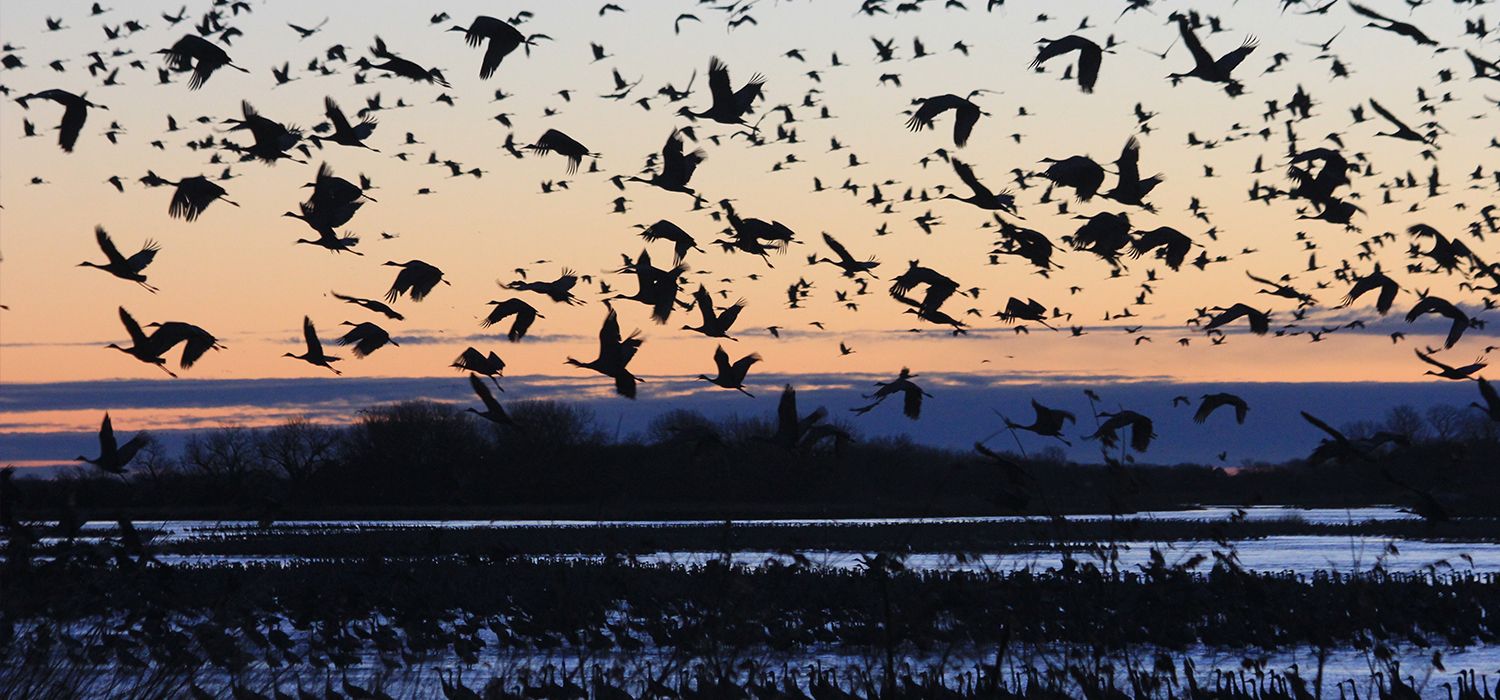- What does your organization do?
- How can I get involved?
- If I were to donate funds, how is my money used?
- What is your organization's privacy policy?
- When is the best time to see the Sandhill Cranes?
- Where is the best place to view the migrating birds?
- Where can I stay during my trip to view the migration?
- Are children or pets allowed in the blinds?
-
Through land management, scientific research, and education, we protect and maintain the physical, hydrological and biological integrity of the Big Bend area of the Platte River so that it continues to function as a life support system for Whooping Cranes, Sandhill Cranes and other migratory bird species. For a list of specific programs and services we provide, visit our What We Do section.
-
We welcome individuals like you wanting to get involved. Visit our How To Help section to find out ways to donate or volunteer.
-
The Crane Trust is an independent non-profit organization that depends on your generous support to protect and preserve critical habitat for the endangered whooping crane and sandhill cranes. You can help ensure that cranes and other migratory birds will continue to thrive along the Platte River for years to come.
The Crane Trust is a 501(C)3 non-profit formally named the Platte River Whooping Crane Maintenance Trust, Inc. EIN 47-0623996
Your support is essential for successful habitat restoration and protection, outreach efforts to engage the community, and other projects to sustain resources for cranes and countless other species sharing fragile river and prairie ecosystems. Read More by clicking the link above.
-
What is your organization's privacy policy?
Our organization takes our privacy policy seriously and takes steps to protect and ensure the safety of our supporters. We do not sell or otherwise disclose information about our volunteers or supporters outside of our immediate organization. This policy has no exceptions. We do not sell or exchange your information with any other organizations, public, private or nonprofit.
-
When is the best time to see the Sandhill Cranes?
Prospective crane-viewers ask this question frequently. Here’s the simple answer for those planning a trip to Nebraska: mid to late March gives you virtually a 100% chance of seeing plenty of sandhill cranes. Casual crane viewers need not read further.
This brings us to our more nuanced answer: The entire month of March, plus early April, can be excellent for sandhill crane viewing in Nebraska. The time you choose will depend on you and your expectations.
Early (first half of March): Although the first sandhill cranes may arrive in mid-February, large numbers often don’t appear until early March. Timing of early arrivals can vary considerably from year to year, depending in part on the severity of the current winter. Long spells of exceptionally cold weather in the Platte River valley can delay the migration, making viewing in the first week of March a little dicey.
Early March also sees large flocks of snow geese piling into ponds and wetlands, sometimes by the tens of thousands. While stunning to watch, these high concentrations can result in outbreaks of avian cholera, which kill thousands of geese. Snows also fall as prey to bald eagles, a frequent sight at this time. Adult balds in flight make magnificent viewing, but are mixed blessings for crane watchers; cranes recognize eagles as predators and will sometimes bolt from a river roost before an eagle flyover. These sudden en masse takeoffs are spectacular but short-lived experiences, sometimes bringing a guided crane tour to an abrupt end.
Middle (latter half of March): As mentioned, this is the usual peak of the sandhill crane migration, with estimates ranging up to a half-million birds in the central Platte valley. However, this “peak” can be misleading. Research shows the first crane arrivals generally use the portion of the Platte south of Grand Island and Alda. As a certain portion of habitat can only hold so many birds, new crane arrivals begin to fill in suitable portions of the river further west. So while more cranes may be in the region as a whole, you may not notice much difference in one particular spot on a day-to-day basis. Even so, this period is generally the best and safest crane-viewing bet, particularly if this is a once-only trip. Not surprisingly, this time also sees the peak of human visitation; those wishing to take guided viewing tours are encouraged to make reservations well in advance.
By this time, the snow geese and many of the bald eagles have usually left the region. A few species of waterfowl might be found on ponds, the river and particularly in the Rainwater Basin south of the Platte River.
Late (early April): While viewing occasionally peaks before this time, in most years Sandhill Cranes begin to leave as April opens, with many birds gone by mid-month. Also, the cranes’ main source of food — waste corn from the previous fall’s harvest — runs low in fields near the Platte River, forcing the birds to spread out as far as 12 miles either side of the river. Flocks at this time are often more dispersed.
Even so, this viewing time offers advantages. The evening gatherings along the river are still awe-inspiring, with longer, warmer days and later sunsets making for more comfortable conditions. Spots in guided tours are much easier to come by as visitation slows. With remaining cranes often full of corn and less in need of finding food, they’ll sometimes linger in one place for longer stretches. They also seem to congregate nearer roadsides.
This time is also your best chance of catching a rare Whooping Crane. With about 300 or so in the wild flock, your odds of seeing this tallest of the North American birds are slender at best. If you’re lucky enough to spot one, please do not approach it. Contact Whooper Watch and enjoy this rare and magnificent sight — even if it doesn’t allow an award-winning photograph.
Keep in mind that, no matter when during the migration you look, day-to-day weather plays a major role in how the cranes behave. A warm, sunny day may keep them in the fields longer, where as a windy, snowy day often brings birds to the river well before sunset. If you’re traveling here specifically for the sandhill show, allow for at least two days of viewing if possible, just in case inclement weather during one day doesn’t spoil your entire trip.
-
Sunrise and sunset are your best opportunities to catch them on the Platte River. You can book a public viewing tour on our website to get in a blind close to the river. The main goal of doing these viewing blind tours before sunrise and sunset is to avoid disturbing the roost.
During the day you can usually try the fields along Platte River Rd. which is south of the Nature & Visitor Center off Alda Rd., take a left on the road after the bridge. You can also stop into the center and check with volunteers for the most current day time viewing locations. For more information about self-guided crane viewing, visit: https://visitgrandisland.com/events/sandhill-cranes-migration.html
-
You can reserve an all-inclusive VIP experience with the Crane Trust which include meals, comfortable lodging and two viewings. The cost is comparable if you were to book these items separately and eat out plus you'll be giving back to help the Crane Trust's conservation efforts. For details, please contact reservations@cranetrust.org or 308.833.3808.
To learn about lodging, restaurants, and other attractions in our area, please see https://visitgrandisland.com/ and https://visitkearney.org/
-
Are children or pets allowed in the blinds?
Although children under 12 years old are not allowed to go into the blinds by the river, there are many activities at the Visitor Center for children to enjoy. We have an animal display room where children can see animals that are found on the prairie. We also have bison that can be viewed while walking down to the channel, with two footbridges leading to 10 miles of walking trails. There is plenty to see on the trails and our gift shop stocks pamphlets to help families recognize wild flowers, grasses and trees found on the trails.
In the daytime the cranes are out feeding on corn in the neighboring corn fields. The Visitor Center can provide information on where the cranes can be found that day so that would be a good opportunity to take children under 12 to see them from the comfort of your vehicle.
Pets are not allowed on the property for the safety of all guests and wildlife, and to reduce the risk of disturbing the roost during the spring migration. Service animals are allowed in the Nature & Visitors Center but are not permitted in the blinds by the river. Thank you for your understanding.

